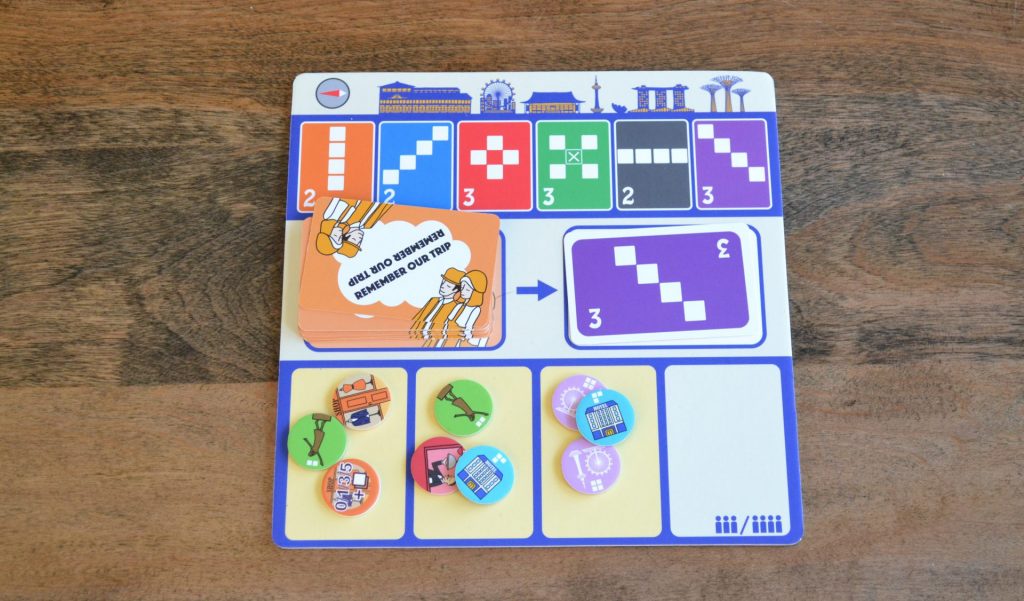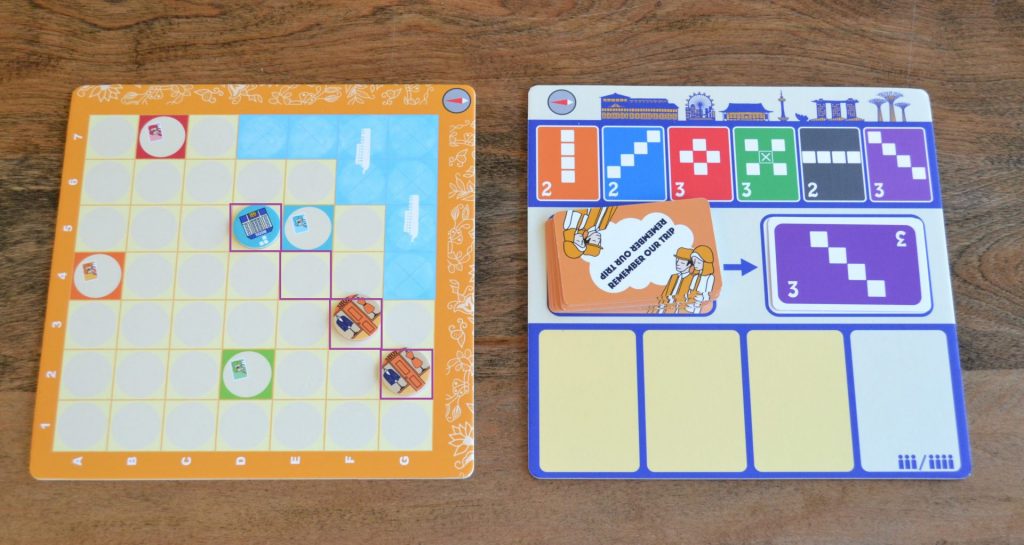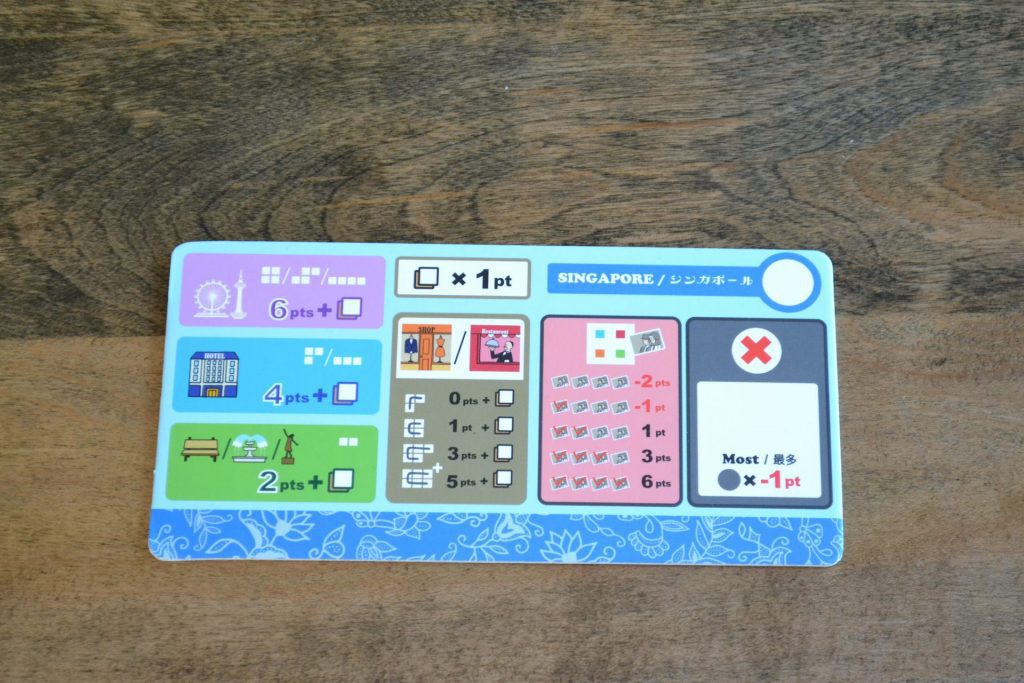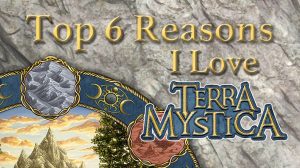In Remember Our Trip, players are laying tiles on their individual player boards (called Image Boards) to form landmarks from the recent trip they took together. As the game progresses, locations that the players remember will be added to the Common Map Board, but make no mistake: this is not a cooperative game.
How to Play
Before starting to play, you need to set up your boards. This isn’t something I normally go over, but in this case it’s particularly important. First, you pick which of the two available cities you are all remembering: Kyoto or Singapore. All the boards (with the exception of the Scoring Board, and Action Board) should be flipped to the agreed upon city side. Next, all the individual Image Boards, the Common Map Board, and the Action Board should all have their compass pointing in the same direction (I like to call this “Board Game North”). Since this game revolves around building a central map, the orientation of the boards is especially important.

Remember Our Trip is played over 12 rounds and each round can be broken into three phases: select, place, score. It should be noted, these aren’t the official phases the rulebook describes, but I think they are easier to understand.
Select
First, in turn order, each player will select a pile of tiles known as Image Tokens. Image Tokens represent the type of location you will remember: attractions, hotels, parks, shops, and restaurants. They’re put out randomly on the Action Board, filling a number of spots that correspond to player count. There will be either 2 or 3 tiles per pile in a round. This is determined by the round’s Memory Card.

Place
Next, once all players have their tiles, they will simultaneously place their Image Tokens on their Image Board, following the pattern on the Memory Card. Each card shows a pattern of four potential placement spots, and all your tokens for this round must be placed in relation to each other to match that pattern. It’s important to note that the Action Board also has a compass, so the pattern on the Memory Card cannot be flipped or mirrored.

Score
Once the tokens are placed, players are given the chance to confirm locations on their board. Players confirm locations by identifying clusters of tokens that form the location shape corresponding to their type. As an example, a park location requires two adjacent park tokens.
Confirmation happens in turn order. Turn order is important because confirming a location has two steps:
- Turn the tokens over on your board that form a location and score the location-specific points shown on the player aid. You will always receive these points, regardless of what is on the Common Map Board.
- Check to see if the spaces you confirmed are free on the Common Map Board. If they are, place the corresponding Location Tile(s) on the map. Next, get a bonus point for each square on the map that matches a spot you just confirmed (whether or not you were the one who placed the Location Tile on the Common Map Board). The Common Map and Image Boards have a grid that’s labelled alpha-numerically (think Battleship), so it is easy to quickly check if a square matches.

After all players have had a chance to confirm locations, the Start Player Marker rotates and the next round begins.
Game End
The game ends after 12 rounds. After the final round, players will score end-game points before determining a winner.
There are three types of end-game points:
- The Goal Card: This randomized card will give players points if they achieved the objective.
- Photographs: There are four identical spots on each Image Board that you and your travel companions took pictures at. You want to match the Image Token colour with what is outlined on your map. This will either cost you points (if you matched 0-1) or gain you points (if you matched 2-4)
- Mistaken memories: If you have the most “mistaken memories” you’ll lose 1 point per token. A mistaken memory is an Image Token that you couldn’t place (the pattern made it go off the board or into the water) or that you replaced with another. Any tile can be replaced if it hasn’t yet been confirmed (flipped over).

Final Thoughts
I’ll start off by saying this game is great. Saashi & Saashi managed to create a completely original game, and in an over-saturated market that’s truly impressive. The combination of token selection, token placement rules, and a common map is absolutely unique.
What’s even more impressive is that the theme of Remember Our Trip really shines through. It feels like the mechanics of the game were developed for the theme, and that’s pretty rare. Every time I’ve played this game, regardless of whether it was a player’s first time or not, there have been jokes made about certain players not remembering that the fireworks we’d seen had been there or that our hotel was actually just a little to the north. Players teased each other for their “bad memory” and it really felt like we were trying to Remember Our Trip together.
I’d also like to talk about the quality of the components. They pack a lot into this perfectly-sized small box. With high-quality cardboard and vibrant colours, this game is visually exciting. I’d also like to point out that the tokens may be the highest quality cardboard punch I’ve ever experienced. There’s literally no sign that they were once part of a punch-board. The edges of each circle are perfectly smooth the whole way around. It’s actually quite satisfying.

The only real complaint I have with this game is about the rulebook. The game is fairly simple to learn, but this isn’t reflected in the rulebook itself. With the large amount of text, images, and flowcharts, I was amping myself up for a far more complicated game. And yet, with all of this content, I still had some questions after reading the rules. This is made up for by the fact that the game has excellent player aids that outline all the scoring steps. The graphic design really is well thought out, but I would like a more clear and concise rulebook. However, since it’s been translated from Japanese, this is a minor complaint.
Amusingly, one of the biggest challenges myself and many of my friends had was stopping ourselves from mirroring our opponent’s player boards in our heads. In Remember Our Trip, all boards are facing the same way, “Board Game North”. This presented a weird problem: in most games, a player’s board faces them, which forces you to re-imagine their board if you’re taking stock of what they’re up to. And it’s hard to get out of that habit. This is a bigger challenge on the Kyoto map than the Singapore one because Singapore’s corner-of-the-board bay is more visually distinct than Kyoto’s river, which runs almost through the centre. If your group is having trouble not mentally flipping the board, I recommend playing on the Singapore side.

Remember Our Trip is a delightful light strategy tile-placement game that can really get your brain working. I’m so grateful that I was given the opportunity to review this game, otherwise I’m not sure if I’d ever have been exposed to it. It’s not always easy to get these smaller import games. If you get a chance to play or buy Remember Our Trip, I highly recommend doing so!
Six Month Update
Due to the Covid-19 Pandemic and restrictions on social gatherings this game hasn’t made it to the table again since the review. This is not a reflection of my feelings towards the game, and I hope to get it back on the table once board games have become a regular part of my life again.











Add this one to my ‘must buy’ list. Thanks for a wonderful review!